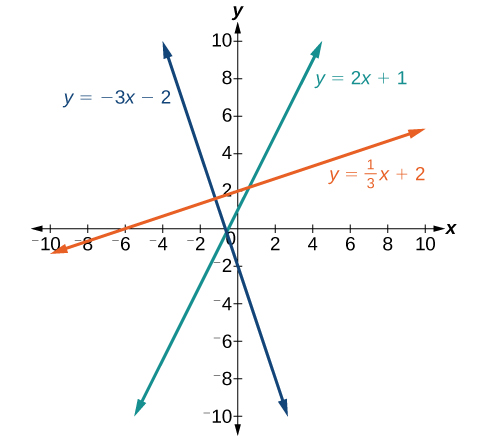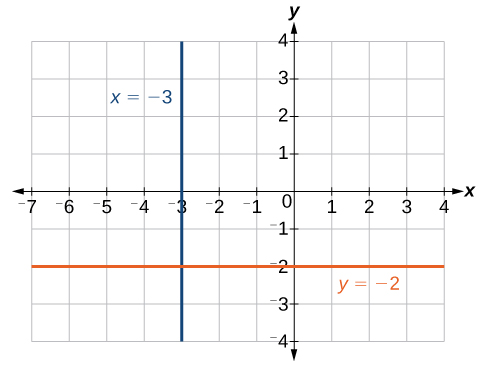Writing Equations of Lines
Learning Outcomes
- Use slope-intercept form to plot and write equations of lines.
- Use point-slope form to write the equation of a line.
- Write the equation of a line in standard form.
- Recognize vertical and horizontal lines from their graphs and equations.
Slope-Intercept Form
Perhaps the most familiar form of a linear equation is slope-intercept form written as [latex]y=mx+b[/latex], where [latex]m=\text{slope}[/latex] and [latex]b=y\text{-intercept}[/latex]. Let us begin with the slope.The Slope of a Line
The slope of a line refers to the ratio of the vertical change in y over the horizontal change in x between any two points on a line. It indicates the direction in which a line slants as well as its steepness. Slope is sometimes described as rise over run.
A General Note: The Slope of a Line
The slope of a line, m, represents the change in y over the change in x. Given two points, [latex]\left({x}_{1},{y}_{1}\right)[/latex] and [latex]\left({x}_{2},{y}_{2}\right)[/latex], the following formula determines the slope of a line containing these points:Example: Finding the Slope of a Line Given Two Points
Find the slope of a line that passes through the points [latex]\left(2,-1\right)[/latex] and [latex]\left(-5,3\right)[/latex].Answer: We substitute the y-values and the x-values into the formula.
Analysis of the Solution
It does not matter which point is called [latex]\left({x}_{1},{y}_{1}\right)[/latex] or [latex]\left({x}_{2},{y}_{2}\right)[/latex]. As long as we are consistent with the order of the y terms and the order of the x terms in the numerator and denominator, the calculation will yield the same result.Try It
Find the slope of the line that passes through the points [latex]\left(-2,6\right)[/latex] and [latex]\left(1,4\right)[/latex].Answer: [latex]x=-5[/latex]
[ohm_question]1719[/ohm_question]Example: Identifying the Slope and y-intercept of a Line Given an Equation
Identify the slope and y-intercept given the equation [latex]y=-\frac{3}{4}x - 4[/latex].Answer: As the line is in [latex]y=mx+b[/latex] form, the given line has a slope of [latex]m=-\frac{3}{4}[/latex]. The y-intercept is [latex]b=-4[/latex].
Analysis of the Solution
The y-intercept is the point at which the line crosses the y-axis. On the y-axis, [latex]x=0[/latex]. We can always identify the y-intercept when the line is in slope-intercept form, as it will always equal b. Or, just substitute [latex]x=0[/latex] and solve for y.Recall operations on fractions
Fractions are commonly encountered when writing equations for lines using the point-slope formula. Being able to multiply or add and subtract fractions will enable you to avoid decimal approximations for numbers like [latex]\dfrac{1}{3}[/latex] or [latex]\dfrac{5}{7}[/latex]. Adding or subtracting fractions: [latex]\dfrac{a}{b}\pm\dfrac{c}{d} = \dfrac{ad \pm bc}{bd}[/latex] Multiplying fractions: [latex]\dfrac{a}{b}\cdot\dfrac{c}{d} = \dfrac {ac}{bd}[/latex] Don't forget to simplify fractions in your final answer!The Point-Slope Formula
Given the slope and one point on a line, we can find the equation of the line using point-slope form.A General Note: The Point-Slope Formula
Given one point and the slope, using point-slope form will lead to the equation of a line:Example: Finding the Equation of a Line Given the Slope and One Point
Write the equation of the line with slope [latex]m=-3[/latex] and passing through the point [latex]\left(4,8\right)[/latex]. Write the final equation in slope-intercept form.Answer: Using point-slope form, substitute [latex]-3[/latex] for m and the point [latex]\left(4,8\right)[/latex] for [latex]\left({x}_{1},{y}_{1}\right)[/latex].
Analysis of the Solution
Try It
Given [latex]m=4[/latex], find the equation of the line in slope-intercept form passing through the point [latex]\left(2,5\right)[/latex].Answer: [latex-display]y=4x - 3[/latex-display]
[ohm_question]110942[/ohm_question]Example: Finding the Equation of a Line Passing Through Two Given Points
Find the equation of the line passing through the points [latex]\left(3,4\right)[/latex] and [latex]\left(0,-3\right)[/latex]. Write the final equation in slope-intercept form.Answer: First, we calculate the slope using the slope formula and two points.
Analysis of the Solution
Standard Form of a Line
Another way that we can represent the equation of a line is in standard form. Standard form is given asExample: Finding the Equation of a Line and Writing It in Standard Form
Find the equation of the line with [latex]m=-6[/latex] and passing through the point [latex]\left(\frac{1}{4},-2\right)[/latex]. Write the equation in standard form.Answer: We begin by using point-slope form.
Try It
Find the equation of the line in standard form with slope [latex]m=-\frac{1}{3}[/latex] which passes through the point [latex]\left(1,\frac{1}{3}\right)[/latex].Answer: [latex]x+3y=2[/latex]
[ohm_question]110946[/ohm_question]Vertical and Horizontal Lines
The equations of vertical and horizontal lines do not require any of the preceding formulas, although we can use the formulas to prove that the equations are correct. The equation of a vertical line is given as The line x = −3 is a vertical line. The line y = −2 is a horizontal line.
The line x = −3 is a vertical line. The line y = −2 is a horizontal line.try it
Use an online graphing calculator to graph the following:- A horizontal line that passes through the point (-5,2)
- A vertical line that passes through the point (3,3)
Example: Finding the Equation of a Line Passing Through the Given Points
Find the equation of the line passing through the given points: [latex]\left(1,-3\right)[/latex] and [latex]\left(1,4\right)[/latex].Answer: The x-coordinate of both points is 1. Therefore, we have a vertical line, [latex]x=1[/latex].
Try It
Find the equation of the line passing through [latex]\left(-5,2\right)[/latex] and [latex]\left(2,2\right)[/latex].Answer: Horizontal line: [latex]y=2[/latex]
[ohm_question]110951[/ohm_question] [ohm_question]110952[/ohm_question]Licenses & Attributions
CC licensed content, Original
- Revision and Adaptation. Provided by: Lumen Learning License: CC BY: Attribution.
CC licensed content, Shared previously
- College Algebra. Provided by: OpenStax Authored by: Abramson, Jay et al.. License: CC BY: Attribution. License terms: Download for free at http://cnx.org/contents/[email protected].
- Question ID 1719. Authored by: Barbara Goldner. License: CC BY: Attribution. License terms: IMathAS Community License CC- BY + GPL.
- Question ID 110942, 110946, 110951, 110952. Authored by: Lumen Learning. License: CC BY: Attribution. License terms: IMathAS Community License CC- BY + GPL.
CC licensed content, Specific attribution
- College Algebra. Provided by: OpenStax Authored by: OpenStax College Algebra. Located at: https://cnx.org/contents/[email protected]:1/Preface. License: CC BY: Attribution.
